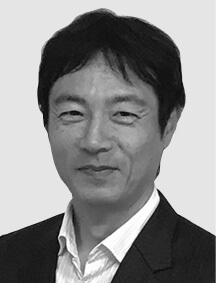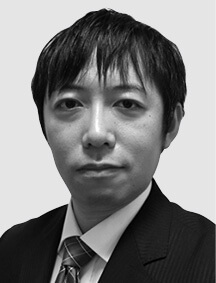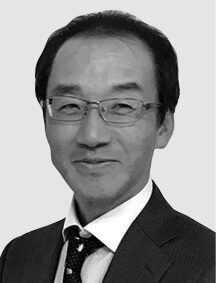Innovation for Next-generation Energy[ⅰ]Power GridsFuture Vision of Society around Electric Power Distribution Business Utilizing Digital Technology
Highlight
The society around the electric power distribution business has been facing major changes over recent years, including electricity system reform, aging equipment, and increasing use of renewable energy. The challenge for transmission and distribution system operators as they navigate these changes is to seize the new business opportunities that arise without compromising the reliability and economics of the electricity network. With the aim of suggesting a consistent way forward for the electric power distribution business that experiences rapid change in the environment in which it operates, Hitachi has collated the ideas generated by investigating a future vision of society around electric power distribution business from a “flat” perspective that puts aside the constraints of technology and regulatory framework. In the future, Hitachi intends to supply new solutions aimed at this future vision while also addressing the needs of transmission and distribution system operators.

1. Introduction
The environment in which Japan’s electric power distribution business operates has undergone major changes over recent years. Along with such challenges as the need for grid stability measures to handle the increasing use of renewable energy, the rising maintenance costs associated with the widespread aging of equipment(1), and the difficulty of maintaining work quality given the prospect of large numbers of experienced workers retiring from the workforce(2), the industry is also facing major structural changes due to the legal unbundling of transmission and distribution from other activities that formed part of the electricity system reforms introduced in April 2020(3). The challenge for transmission and distribution system operators in this environment is to seize the new business opportunities it offers without compromising the reliability and economics of the electricity network.
Meanwhile, dramatic advances are being made in digital technologies such as artificial intelligence (AI) and the Internet of Things (IoT), giving rise to new solutions and services in a variety of industries. In electricity distribution, there is potential for using new technologies to overcome the challenges facing transmission and distribution system operators. In the use of digital technology, rather than just the resolution of immediate challenges, it is also important that this use turns the changes into opportunities, in anticipation of medium- and long-term visions of the future.
Accordingly, Hitachi believes that its ability to contribute to the sector’s sustainable progress by identifying solutions that utilize digital technology and using collaborative creation against the issues and requirements of the electric power distribution business in Japan and, has devised a future vision of society around the Japanese electric power distribution business. This was accompanied by an investigation into a direction of solutions that are likely to be needed in the future to realize this future vision.
2. Future Vision of Society around Electric Power Distribution Business
2.1 19 Specific Changes in Electric Power Distribution Business
Hitachi considered specific changes up to 2030 to analyze a future vision of society around the electric power distribution business. Using an analysis of politics, economy, society, and technology (PEST), this study not only considered factors relating to government and transmission and distribution system operators but also emphasized the consumers who use electric power and the changes in value for local communities. Approximately 70 changes were categorized on the basis of PEST, from which 19 specific changes were then obtained that were deemed to have a high relevance to the electric power distribution business.
While these changes were considered from a nationwide perspective, their characteristics in fact vary from area to area. Accordingly, changes relating to the consumers and local communities were classified into six areas (major cities, regional cities, regional suburbs, rural, uninhabited, and offshore islands) together with an additional “all areas” category. A further category of “transmission and distribution” was also used for those changes with relevance to transmission and distribution system operators.
The 19 changes are listed below.
- Increasing numbers reaching the end of the feed-in tariff (FIT) scheme leads to the emergence of new market participants and a shift to in-home consumption. (2020 onwards, all areas)
- The legal unbundling of transmission and distribution from other activities leads to a need for commercial transparency as well as the need to combine the pursuit of operational efficiency with maintenance of reliability of supply. (2020 onwards, transmission and distribution)
- The rising number of younger people brought up with environmentalism makes environmental awareness the default. (2020 onwards, major cities, regional cities)
- The availability of very high-speed/low-latency communications shifts many activities online leading to growing use of various resources. (2020 onwards, all areas)
- Falling costs make batteries a key device. (2025 onwards, all areas)
- Progress in organizational consolidation in pursuit of openness in corporate data and of operational efficiencies, as well as progress in cross-industry coordination linked by data. (2025 onwards, major cities, regional cities)
- Regional variations in the amount of wheeling become more pronounced and it becomes increasingly difficult to operate all equipment at the same level. (2025 onwards, rural, uninhabited, and offshore islands, transmission and distribution)
- Rising maintenance costs due to widespread aging of equipment create a need for equipment to be upgraded in ways that minimize capital investment. (2025 onwards, transmission and distribution)
- Rising frequency and severity of disasters leads to increasing public concern. The level of disaster preparedness and services becomes a factor in choosing where to live. (2020 onwards, all areas)
- Growing diversity in working practices leads to population becoming more mobile and dispersed. (2022 onwards, major cities, regional cities)
- The spread of the sharing economy increases the number of people who do not own a home or vehicle. (2023 onwards, major cities)
- Increasing numbers of service operators utilize energy storage. (2025 onwards, major cities, regional cities)
- Use of blockchain leads to the widespread trading of energy and added value by companies and individuals. (2025 onwards, major cities)
- The concentration of population in cities increases the number of communities that are struggling to remain viable. (2030 onwards, rural, uninhabited, offshore islands)
- An increase in the number of communities being set up on offshore islands and other remote locations with closed energy infrastructure brings new entrants to the electric power distribution business. (2025 onwards, regional suburbs, rural, and offshore islands)
- Changes in people’s values and their “long-tail distribution” leads to more small communities being set up based on shared values. (2030, major cities, regional cities)
- Ongoing technical innovation in batteries and electrification of public transportation improves energy portability. (2030, major cities)
- Rising corporate awareness of environmental value leads to more companies supporting Renewable Energy 100 (RE100). (2020 onwards, major cities, regional cities)
- Greater installation of renewable energy requires action to be taken on grid links and operation. (2020 onwards, regional cities, regional suburbs, transmission and distribution)
These changes include a number that relate to energy storage. While past practice has been for electric power to be shared across the grid, further technical innovation and falling costs for energy storage have the potential to significantly impact the structure of industry by bringing major changes to existing energy supply chains.
2.2 Nine Future Visions of Society around Electric Power Distribution Business
With reference to the above, Hitachi went on to collate a number of future scenarios that consider how the residents of each of the six areas will live and how electricity will be distributed in 2030 (see Figure 1). The following sections describe the key points for each case. In addition, future directions for transmission and distribution system operators are also categorized either as enhancements to existing practices or as new business areas or profit centers.
Fig. 1—Overview of Future Vision of Society Around Electric Power Distribution Business Utilizing Digital Technology Based on the changes identified for six areas (major cities, regional cities, regional suburbs, rural, uninhabited, and offshore islands), a scenario for how people will live and how electricity distribution will be handled in each of these areas in 2030 was collated in the form of a future vision.
Based on the changes identified for six areas (major cities, regional cities, regional suburbs, rural, uninhabited, and offshore islands), a scenario for how people will live and how electricity distribution will be handled in each of these areas in 2030 was collated in the form of a future vision.
Fig. 2—End Users’ Lifestyles and Power Distribution Works in Future Visions (a) and (b)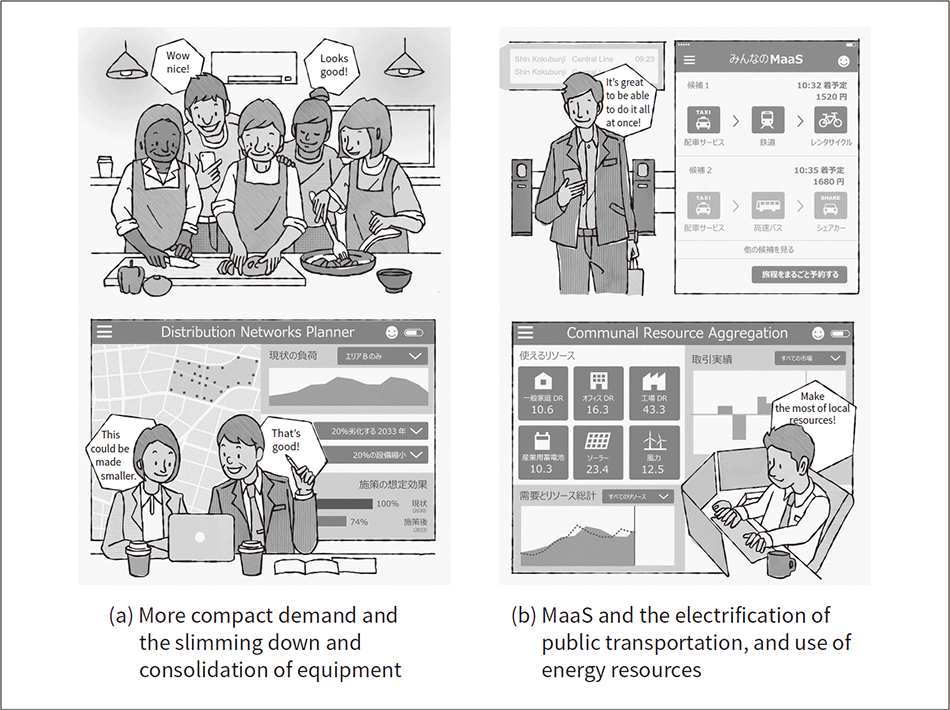 Vision (a) involves more communities being set up based on shared values leading to infrastructure becoming more compact. Vision (b) involves the electrification of mobility as it increasingly becomes a service, and also the ability to make use of it in grid operation.
Vision (a) involves more communities being set up based on shared values leading to infrastructure becoming more compact. Vision (b) involves the electrification of mobility as it increasingly becomes a service, and also the ability to make use of it in grid operation.
Fig. 3—End Users’ Lifestyles and Power Distribution Works in Future Visions (c) and (d)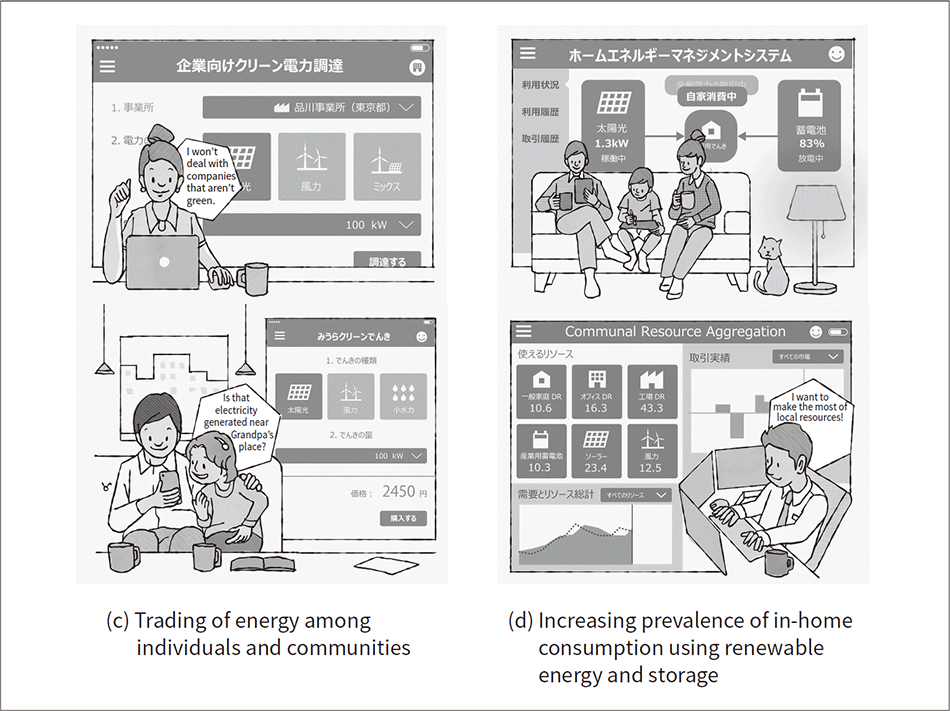 Vision (c) involves an increase in virtual energy trading between individuals, communities, and companies as a greater emphasis is placed on environmental value. Vision (d) involves more homes in regional cities generating their own electricity in a way that can help with grid operation.
Vision (c) involves an increase in virtual energy trading between individuals, communities, and companies as a greater emphasis is placed on environmental value. Vision (d) involves more homes in regional cities generating their own electricity in a way that can help with grid operation.
Fig. 4—End Users’ Lifestyles and Power Distribution Works in Future Visions (e) to (g) Vision (e) involves more collaboration between companies to improve operational efficiency, such as by coordinating construction planning. Vision (f) involves a wide variety of human resources, including retired former workers and people from overseas, participating in operations remotely to help deal with the shortage of resources. Vision (g) involves companies operating equipment efficiently by sharing it with each other.
Vision (e) involves more collaboration between companies to improve operational efficiency, such as by coordinating construction planning. Vision (f) involves a wide variety of human resources, including retired former workers and people from overseas, participating in operations remotely to help deal with the shortage of resources. Vision (g) involves companies operating equipment efficiently by sharing it with each other.
Fig. 5—End Users’ Lifestyles and Power Distribution Works in Future Visions (h) and (i)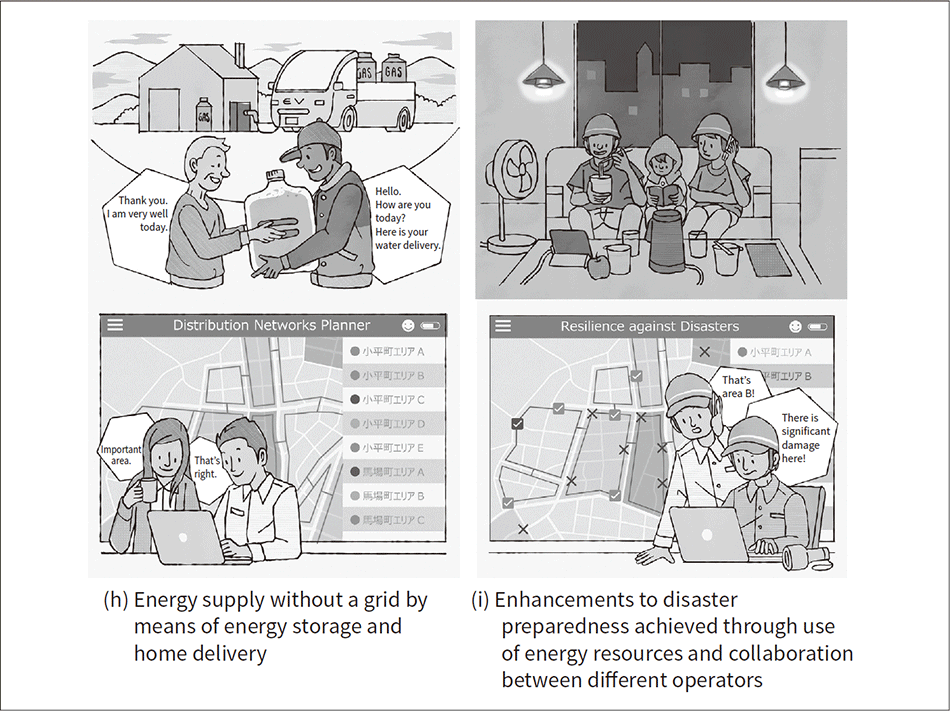 Vision (h) involves the partial replacement of energy supplies with batteries and home delivery. Vision (i) involves collaboration between different stakeholders on disaster preparedness, taking advantage of the widespread adoption of energy storage.
Vision (h) involves the partial replacement of energy supplies with batteries and home delivery. Vision (i) involves collaboration between different stakeholders on disaster preparedness, taking advantage of the widespread adoption of energy storage.
- More compact demand and the slimming down and consolidation of equipment [major cities; regional cities; changes (2), (5), (8), (11), and (16)]
As consumer needs and values become more diverse, an increasing number of people choose where to live based on lifestyle. In particular, this involves an increase in services for community-based living among people who share particular values, such as hobbies, interaction with people from other countries, and environmentalism, leading to more compact cities in conjunction with the establishment of small communities within cities.
Transmission and distribution system operators utilize smart meter and other data to monitor and predict actual loads, becoming more compact by slimming down and consolidating infrastructure in accordance with the actual load at the timing of upgrades. (Enhancement to existing practices) - Promotion of mobility as a service (MaaS) and the electrification of public transportation, and use of energy resources [major cities; changes (5), (11), (17), and (18)]
Mobility increasingly becomes a service, with the emergence of new forms of public transportation and its electrification. Transmission and distribution system operations act as aggregators for a variety of energy resources, making use of these in grid operation. (New business area or profit center)
Figure 2 shows an outline of future visions (a) and (b).
- Trading of energy among individuals and communities [major cities; regional cities; changes (3), (5), (12), (13), and (19)]
Environmental awareness becomes the default. While people want to reduce the load on the environment, the difficulty of installing their own renewable energy and storage leads to an increase in exchanges of virtual energy. Major cities in particular see a rise in the trading of renewable energy and environmental value due to the difficulty of procuring your own renewable energy. It also becomes standard practice for listed firms to include environmental value among their performance indicators.
Transmission and distribution system operators, meanwhile, see a rise in virtual trading of renewable energy and environmental value between individuals, companies, and communities, along with a need for grid stabilization measures on the actual grid. (Enhancement to existing practices) - Increasing prevalence of in-home consumption using renewable energy and storage [regional cities; changes (1), (3), (5), and (19)]
Numbers of off-grid residences that install their own renewable energy increase in regional cities and suburbs, where there is a greater emphasis on home ownership than there is in major cities. They also see a rise in in-home consumption with larger increases in the installation of renewable energy and storage into residences than in the major cities. Transmission and distribution system operators act as aggregators for a variety of energy resources, making use of these in grid operation. (New business area or profit center)
Figure 3 shows an outline of future visions (c) and (d).
- Operational efficiencies achieved through collaboration between infrastructure operators [major cities; regional cities; changes (2), (6), and (8)]
Operational efficiencies are achieved through collaboration between various infrastructure operators (e.g. electricity distribution, gas, water, and telecommunication), such as by coordinating their construction plans. (Enhancement to existing practices) - Optimization of maintenance work through combined use of diverse resources [major cities; regional cities; changes (2), (4), (6), and (8)]
Enhancements to communication networks allow transmission and distribution system operators to undertake various sorts of work online, with a wide variety of human resources, including retired former workers and people from overseas, being able to participate in operations remotely to help deal with the shortage of resources. (Enhancement to existing practices) - Shared use of other companies’ equipment [all areas (especially regional suburbs); changes (2), (6), and (11)]
Falling demand for electric power makes it difficult in many cases for ordinary transmission and distribution system operators to operate equipment efficiently on their own, leading to companies sharing equipment and loaning it to each other. (New business area or profit center)
Figure 4 shows an outline of future visions (e) to (g).
- Energy supply without a grid by means of energy storage and home delivery [rural, changes (5), (7), (9), and (14)]
While rural areas experience depopulation due to the migration of people to the cities combined with an aging population and low birth rate, some housing and communities still remain.
Variations in transmission volumes become more pronounced in some places with an increasing amount of infrastructure having more capacity than is needed to satisfy actual demand, leading transmission and distribution system operators to consider alternative services for homes in such locations, such as providing batteries and lifestyle services based on home delivery. (Enhancement to existing practices, new business area or profit center) - Enhancements to disaster preparedness achieved through use of energy resources and collaboration between different operators [all areas (especially major cities); changes (5), (6), and (9)]
The level of disaster preparedness and services becomes a factor for people choosing where to live. Greater use is made of batteries for supplying energy during emergencies. Rather than individuals, this use of batteries is mainly by local government, housing complexes, and other organizations that have a degree of scale. Along with increasing electrification of public transportation, the installation of energy storage becomes commonplace at facilities such as hospitals that place a high priority on business continuity planning (BCP).
Energy storage and other such resources are recognized for their role in disaster preparedness and the spread of energy resources leads to the emergence of areas able to maintain the supply of energy during disasters. Transmission and distribution companies recognize this situation and prioritize action accordingly. Various different stakeholders work together on disaster response. (Enhancement to existing practices)
Figure 5 shows an outline of future visions (h) and (i).
3. Study of Solutions and Digital Technologies for Realizing Future Vision
A study was made of the solutions deemed to be of particular importance for this future vision of society around the electric power distribution business in 2030, and also the digital technologies needed to implement them. The following sections list the required solutions and corresponding future vision scenarios, and summarize the solutions.
- Solutions for enhancing operations and improving efficiency through coordination between electricity distribution and infrastructure operators [Future visions (a), (f), and (h)]
In order to overcome shortages of resources for construction, maintenance, and other on-site work, work in the future will need to be performed efficiently by taking advantage of a range of external resources along with the exchange of data and coordination of work between infrastructure operators in a variety of operational and other situations. Creating such an environment will require solutions for cross-industry coordination with other businesses. The requirements for implementing such solutions include IT platforms that link different companies, optimal resource matching based on work and resource data, and optimal scheduling so that different companies can undertake on-site work together in an efficient manner. - Solutions for achieving highly profitable distribution grid management [Future visions (a), (f), and (h)]
While there will be a need to maintain both the reliability and economics of distribution networks at the same time as regional variations in the amount of wheeling become more pronounced, the past practice of operating in the same way across all areas will be difficult to sustain. For this reason, it is anticipated that solutions will be needed that enable distribution infrastructure to operate in an optimal manner with respect to economics. The requirements will include grid assessment techniques that can provide a quantitative view of the balance of income and expenditure in each power distribution system and the risk of faults and other problems, and simulation and optimization techniques for identifying which operation and maintenance practices are appropriate based on grid priorities. - Solutions for enhancing disaster preparedness [Future vision (i)]
To further improve disaster preparedness, there will be a need in the future for solutions that transmission and distribution system operators can use for rapid and accurate damage assessment and information dissemination and to achieve rapid recovery. It is anticipated that there will also be a need in the future for solutions that optimize disaster response by having the various different stakeholders coordinate their resources seamlessly. The requirements for achieving this include techniques for assessing disaster resiliency and the associated bottlenecks (factors that reduce resiliency) as well as ways of maximizing resiliency such as the optimal matching of areas with the energy resources of various different stakeholders, the calculation of recovery priorities, and techniques for optimizing recovery planning. - Solutions that contribute to grid operation through use of energy resources [Future visions (b) and (d)]
The consequences for distribution networks of adding further energy resources (renewable energy and storage) in the future, including voltage fluctuations, will need to be considered, something that will require a large financial investment. It is anticipated that this will require solutions that enable power distribution systems to operate in the most economical manner possible across entire areas, including the use by transmission and distribution system operators of end-user energy resources for this purpose. The requirements for providing such solutions include techniques for assessing the impact of energy resources on distribution networks, analytical techniques for determining where to locate resources so as to minimize these impacts, and ways to manage and control end-user energy resources.
4. Conclusions
This article has considered a future vision of society around the electric power distribution business and the solutions and digital technologies that will be needed by an electricity distribution sector that is experiencing major changes in the environment in which it operates. This future vision offers one way forward for electricity distribution. Accordingly, the future vision presented here and the solutions it requires are something that will be realized in a way that evolves through future trends in society and the process of collaborative creation with transmission and distribution system operators.
Hitachi intends to use collaborative creation to supply new solutions for the future while also addressing the needs of transmission and distribution system operators and of various different stakeholders.
REFERENCES
- 1)
- S. Tanikawa, “An ‘Infrastructure Crisis’ is Approaching,” IT Solution Frontier, Nomura Research Institute, Ltd., pp. 4–5 (Nov. 2009) in Japanese.
- 2)
- T. Funabashi, “Problems related to the Succession of Power Engineering and Securing Human Resources,” The Journal of the Institute of Electrical Engineers of Japan, Vol. 135, No. 12, pp. 829–833 (Dec. 2015) in Japanese.
- 3)
- S. Kusanagi, “The Risks Concerning Legal Unbundling of Electricity Industries: How Can We Deal with Them?,” The Journal of the Institute of Electrical Engineers of Japan, Vol. 135, No. 6, pp. 352–355 (Jun. 2015) in Japanese.




